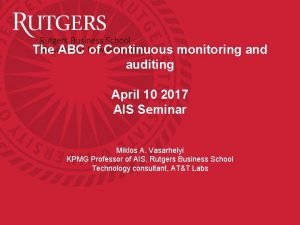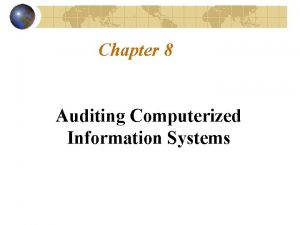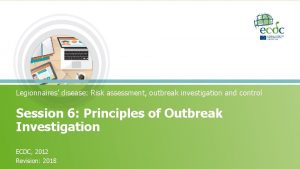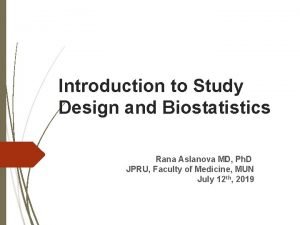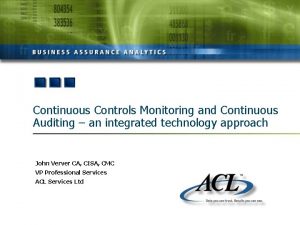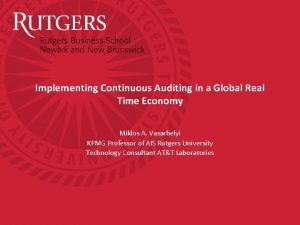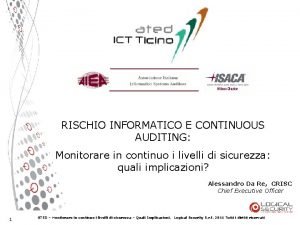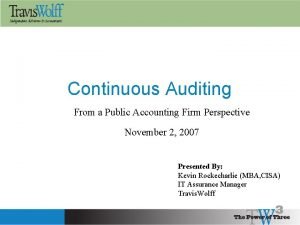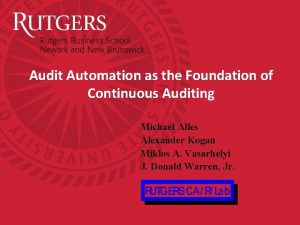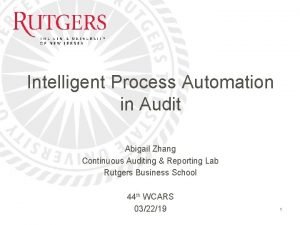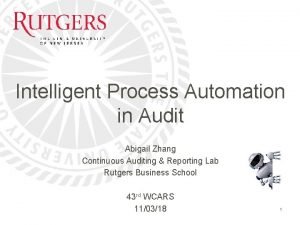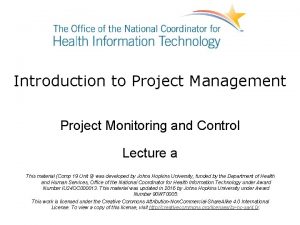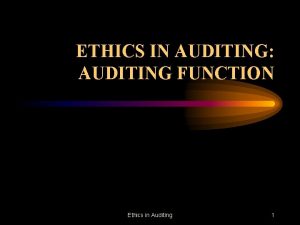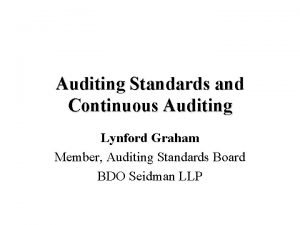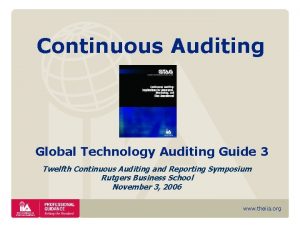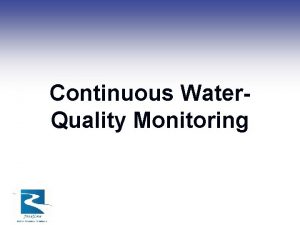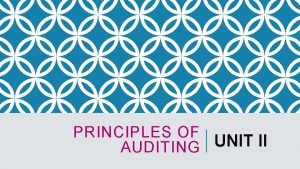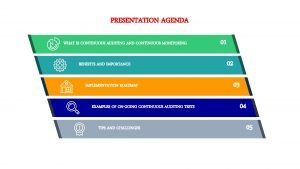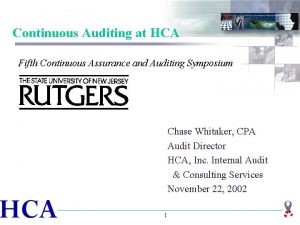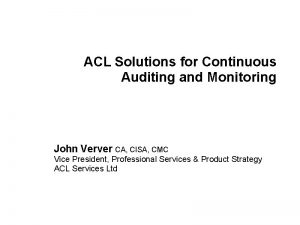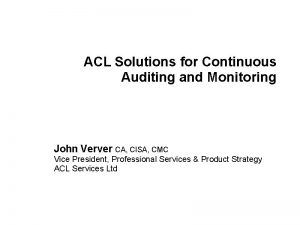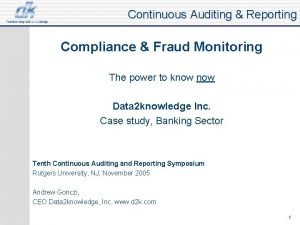Continuous Auditing and Continuous Control Monitoring Case studies
















- Slides: 16

Continuous Auditing and Continuous Control Monitoring: Case studies of technology adoption in leading internal audit organizations and external audit teams Miklos A. Vasarhelyi Siripan Kuenkaikaew Silvia Romero

CA/CM adoption External auditors and CA – Assessment of 4 Audit teams use of CA • Objectives • This study involve field research studies from 4 external audit teams • Examines the status of usage of technology in auditing, its enablers and difficulties Rutgers Business School

CA/CM adoption Methodology • Interviews with audit team managers, IT managers and forensic team managers. • The interviews were conducted face-to-face through site visits. Rutgers Business School

CA/CM adoption Conclusions • Teams report tools are useful – but usage is sparse • Integration between teams – Wide range of outcomes with Approva – suggest leveraging the better practice as to how IT is integrated on team – Background / training of specialists makes a difference • Audit Managers “wish lists” – Data extraction – all teams prefer be in position to do extracts rather than rely on client and then test for reliability – Automated report generation [e. g. IDEA comparison reports] • Synergies between internal and external audit use of tools – No teams mentioned activity that leverages work / tools of internal auditors on the external audit Rutgers Business School 4

CA/CM adoption Leading Organizations Usage of CA/CM Objectives • This study involve field research studies from 9 leading internal audit organizations. • Examines the status of continuous auditing and continuous control monitoring adoption of the organizations. Rutgers Business School

CA/CM adoption Methodology • Interviews with internal auditors, IT internal auditors and internal audit management. • The interviews were conducted face-to-face through site visits. • Interviewees were selected from the internal audit department. At least four employees were interviewed per organization to ensure validity, information completeness, and a range of points of view. Rutgers Business School

CA/CM adoption The Audit Maturity Model (1) Stage 1 Stage 2 Stage 3 Stage 4 Traditional Audit Emerging Maturing Continuous Audit Objectives • Assurance on the financial reports presented by management • Effective control monitoring • Verification of the quality of controls and operational results Approach • Traditional interim and year-end audit IT/Data access • Case by case basis • Data is captured during the audit process • Traditional plus some key monitoring processes • Repeating key extractions on cycles • Usage of alarms as evidence • Continuous control monitoring • Systematic monitoring of processes with data capture • Improvements in the quality of data • Creation of a critical meta-control structure • Audit by exception Audit Automation • Manual processes & separate IT audit • Audit management software • Work paper preparation software • Automated monitoring module • Alarm and follow-up process Rutgers Business School • Complete data access • Audit data warehouse, production, finance, benchmarking and error history • Continuous monitoring and immediate response • Most of audit automated

CA/CM adoption The Audit Maturity Model (2) Stage 1 Stage 2 Stage 3 Stage 4 Traditional Audit Emerging Maturing Continuous Audit and management sharing • Independent and Adversarial • Independent with some core monitoring shared • Purposeful Parallel systems and common infrastructures Management of audit functions • Financial organization supervises audit and matrix to Board of director • Some degree of coordination between the areas of risk, auditing and compliance IT audit works independently Analytic methods • Financial ratios at sector level/account level • Shared systems and resources where natural process synergies allow • IA and IT audit coordinate risk management and share automatic audit processes • Auditing links financial to operational processes • KPI level monitoring • Structural continuity equations • Monitoring at transaction level Rutgers Business School • Centralized and integrates with risk management, compliance and SOX/ layer with external audit. • Corporate models of the main sectors of the business • Early warning system

CA/CM adoption The Audit Maturity Model Traditional Emerging Maturing Continuous Rutgers Business School

CA/CM adoption Factors affect the adoption • Management support – Management support is critical especially for projects requiring considered amount of budget and affecting some operational processes. – It is also necessary that the auditor has access to the systems and data of each auditee (Handscombe 2007). Such access requires management approval. – The audit-aid technology implementation is initiated and supported by the head of the internal audit department or higher level management. – Internal auditors do not have direct access to the data. – With the CA/CM tools, data are automatically extracted without human intervention. Rutgers Business School

CA/CM adoption Factors affect the adoption • Employee knowledge – Hall and Khan (2003) posited that an adoption of new invention might be slow if a success of the implementation requires complex new skills. – Continuous auditing and continuous control monitoring relies on advance technology. – The tools and systems are varied across/within the company, so that an internal auditor needs some basic knowledge or skills for those systems, audit-aid technology and tools. – Standard training, customized training, MBA program – Prefer experienced auditors – Staff rotational program Rutgers Business School

CA/CM adoption Factors affect the adoption • Perceived cost – In this context, cost is not the monetary value but the perception of the adoption cost. – Taylor and Murphy (2004) suggested that high set-up and ongoing costs could be barriers to the implementation of technology. – Searcy and Woodroof(2001): Continuous auditing is increasingly adopted because of a dramatically fallen in a cost of implementation and an availability of support technology. – Cost is not the barrier for the adoption of technology. It was not identified as a top challenge for the implementation. Rutgers Business School

CA/CM adoption Factors affect the adoption • Regulation and compliance – Many of the executives are thinking of continuous auditing as one of the solutions that assist them to comply with the regulation (Handscombe 2007). – SEC 33 -8128 (accelerate the submission of financial report), SOX 404 (internal control quality and on-time report), bank regulation – Although there is no explicit relationship between CA/CM implementation with regulation and compliance, the interviewees report that CA/CM supports SOX fulfillment. – It facilitates the review activities and reduces time allocated to SOX compliance. Rutgers Business School

CA/CM adoption Analysis 1. Most of the companies are at the foundation stage of CA/CM adoption. • Contrasts with the findings of the ACL and internal audit surveys conducted by Pw. C. 2. Lacking audit aid tools such as working paper management and data analysis tools. • i. e. Consumer 1 3. Lack of training for Audit aid tools • Consumer 1 is not successful with the ACL data analysis adoption. 4. Audit like organization Rutgers Business School

CA/CM adoption Analysis 5. IA needs to improve audit competency and technology skill set. – Bank 2 hires Big 4 as a consultant to help in internal audit areas. 6. Some companies have a certain level of CA/CM technology adoption such as Hi-tech 1, Hi-tech 2 and Bank 1. – External auditor can rely on internal audit work at some level. 7. With advanced auditing technology, sufficient access to data is facilitated; for instance, the continuous monitoring system of Bank 1 and the audit tools of Hi-tech 1. – Analyze data in various dimensions and at a deeper level Rutgers Business School

CA/CM adoption Conclusion • Several companies have implemented some advanced audit technologies, however, none of them really has continuous auditing. • Most of them are ranked between stage 1, traditional audit, and stage 2, emerging. • There is opportunity for development in the future. Rutgers Business School
 Jitsmi
Jitsmi Continuous control monitoring tools
Continuous control monitoring tools Auditing through the computer
Auditing through the computer Ifta audit manual
Ifta audit manual Advantages and disadvantages of case control studies
Advantages and disadvantages of case control studies Site:slidetodoc.com
Site:slidetodoc.com Best worst and average case
Best worst and average case Continuous control monitoring definition
Continuous control monitoring definition Paradigm shift from women studies to gender studies
Paradigm shift from women studies to gender studies Continuous auditing definition
Continuous auditing definition Continuous auditing
Continuous auditing Continuous auditing workflow
Continuous auditing workflow Continuous auditing automation
Continuous auditing automation Intelligent process automation in audit
Intelligent process automation in audit Continuous auditing workflow
Continuous auditing workflow Used to show interrupted action in the past
Used to show interrupted action in the past Project monitoring and control
Project monitoring and control
